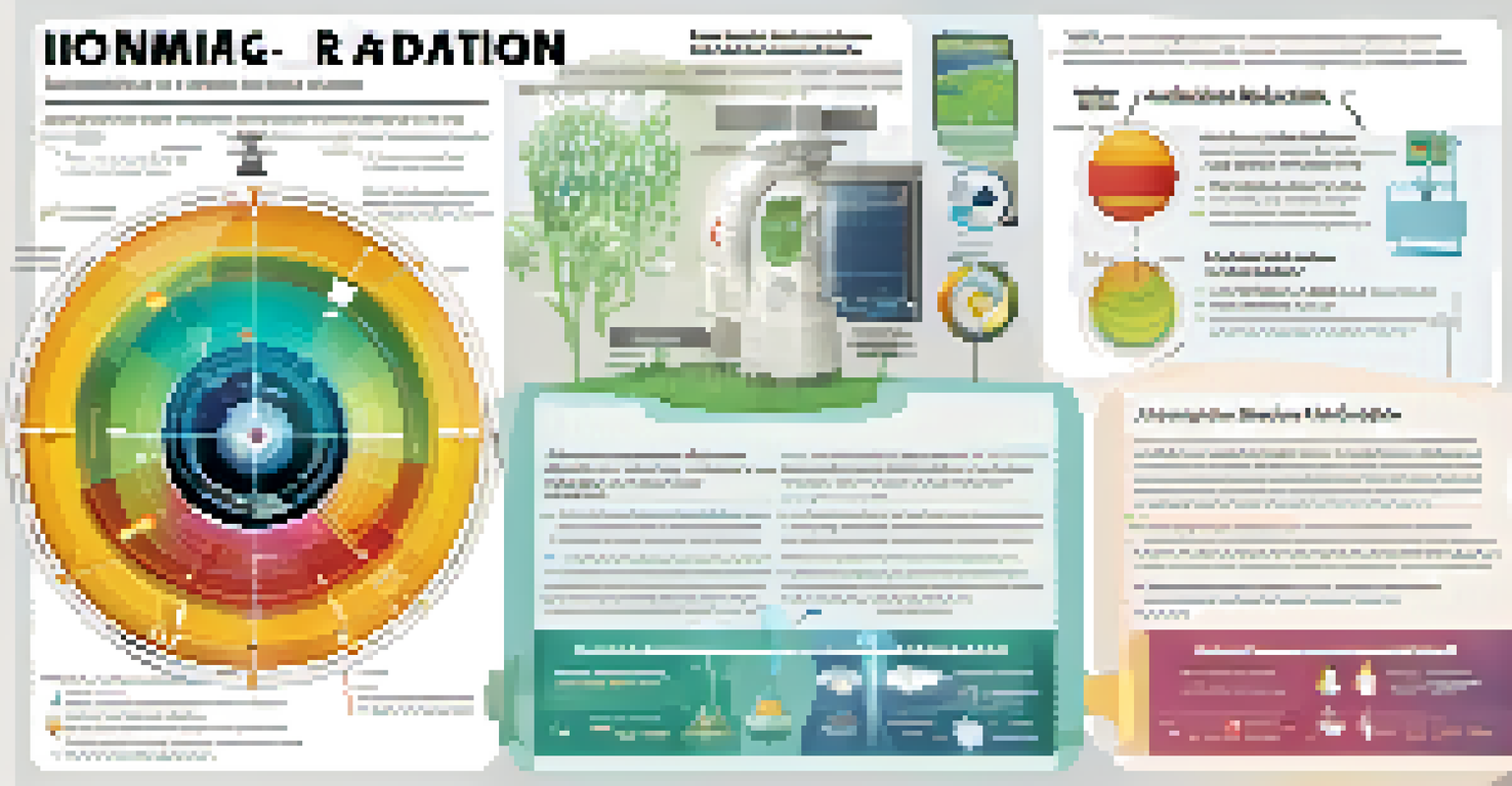Safety in Radiology: Understanding Radiation Exposure Risks

What is Radiation and Its Role in Radiology?
Radiation is energy that travels through space and can take various forms, including electromagnetic waves and particles. In radiology, it is primarily used for diagnostic imaging, helping healthcare professionals see inside the body without invasive procedures. Common imaging techniques that utilize radiation include X-rays, CT scans, and fluoroscopy.
Radiology is the gateway to modern medicine, enabling us to see inside the body without invasive procedures.
While radiation plays a vital role in diagnosing and treating medical conditions, it’s essential to understand that not all radiation is harmful. The type and amount of radiation exposure can significantly affect health outcomes. This understanding helps medical professionals make informed decisions about the necessity and safety of imaging procedures.
For patients, it’s crucial to recognize that the benefits of accurate diagnosis often outweigh the potential risks of radiation exposure. However, awareness and education about these risks are important, as they empower patients to engage in discussions with their healthcare providers regarding their treatment options.
Understanding Radiation Exposure: Types and Sources
Radiation exposure can be classified into two main categories: ionizing and non-ionizing radiation. Ionizing radiation, which includes X-rays and gamma rays, has enough energy to remove tightly bound electrons from atoms, potentially causing cellular damage. Non-ionizing radiation, such as visible light or radio waves, is generally considered safe and does not have the same health risks.

In a medical context, ionizing radiation is primarily used in diagnostic imaging and certain treatments, such as radiation therapy for cancer. The sources of radiation exposure in healthcare can include medical equipment, natural environmental sources, and even cosmic rays from outer space. Understanding these sources helps demystify the concept of radiation exposure.
Understanding Radiation Types
Radiation exposure is classified into ionizing and non-ionizing types, with ionizing radiation being used in medical imaging but requiring careful management due to potential health risks.
Patients often wonder about the cumulative effects of radiation exposure over time. While individual procedures involve low doses of radiation, cumulative exposure from multiple imaging tests can add up. This makes it essential for both patients and doctors to carefully consider the necessity of each imaging procedure.
Evaluating Risks: How Much Radiation is Too Much?
Determining how much radiation exposure is considered 'too much' can be complex, as it varies based on several factors, including age, health status, and the specific type of imaging performed. Medical professionals often refer to the concept of 'as low as reasonably achievable' (ALARA) when making decisions about the use of radiation in imaging. This principle emphasizes minimizing radiation exposure while still obtaining necessary diagnostic information.
The best way to predict the future is to invent it, and in radiology, innovation is key to patient safety and care.
For context, a single chest X-ray typically exposes a patient to about 0.1 millisieverts (mSv) of radiation, which is a relatively low dose. In comparison, the average person receives about 3 mSv annually from natural background radiation. Understanding these numbers can help patients gauge the risks associated with various imaging procedures.
Healthcare providers play a crucial role in ensuring patient safety by weighing the risks and benefits of each imaging test. Open communication about the necessity of each procedure allows patients to make informed decisions and reduces anxiety surrounding radiation exposure.
The Benefits of Radiology: Why It’s Worth the Risk
Despite concerns about radiation exposure, the benefits of radiology are significant. Diagnostic imaging allows healthcare providers to detect diseases at early stages, leading to more effective treatment and better patient outcomes. For instance, early detection of conditions like cancer can dramatically improve survival rates.
Moreover, many imaging techniques are non-invasive, sparing patients from more invasive procedures that carry higher risks. For example, a CT scan can provide detailed information about internal organs without the need for exploratory surgery. This can help reduce recovery times and improve overall patient comfort.
Benefits of Radiology
Despite concerns about radiation exposure, the benefits of radiology, such as early disease detection and non-invasive procedures, significantly outweigh the risks.
It's important to remember that the medical community prioritizes patient safety. Radiologists and technicians are trained to follow strict safety protocols to minimize radiation exposure while maximizing diagnostic value. This commitment to patient care is at the heart of radiology.
Radiation Safety Protocols: How Radiologists Protect Patients
Radiologists and imaging technologists are trained to implement various safety protocols to protect patients from unnecessary radiation exposure. These protocols include using the lowest effective dose of radiation, shielding sensitive body parts, and employing alternative imaging methods, like ultrasound or MRI, when appropriate.
In many facilities, advanced technology is used to optimize imaging procedures. For instance, digital X-ray systems often require less radiation than traditional film X-rays while producing high-quality images. Ongoing training and education for healthcare professionals ensure they stay updated on the latest safety practices.
Patient education is also a critical component of radiation safety. Radiologists often take the time to explain the procedure, its necessity, and any potential risks involved. This transparency fosters trust and allows patients to feel more comfortable during their imaging experience.
What Patients Can Do to Stay Informed and Safe
Patients play an essential role in their healthcare journey, and staying informed about radiation safety can empower them to make better choices. Before undergoing an imaging procedure, patients should ask questions about the necessity of the test, the type of radiation used, and any potential risks. This dialogue can help clarify concerns and ensure that the procedure is necessary.
Keeping a record of past imaging tests can also be beneficial. This information helps healthcare providers assess cumulative radiation exposure and avoid unnecessary repeated tests. Patients should feel encouraged to communicate openly with their healthcare providers about their medical history and any previous imaging procedures they have undergone.
Patient Involvement in Safety
Patients can enhance their safety by asking questions about imaging procedures, keeping records of past tests, and exploring non-radiation alternatives.
Lastly, patients should be aware of alternative imaging options. In many cases, there are non-radiation alternatives, such as ultrasound or MRI, which can be just as effective for certain diagnoses. Engaging in these conversations can lead to safer, more informed healthcare decisions.
The Future of Radiology: Innovations in Safety and Technology
Looking ahead, advancements in technology and safety practices are expected to further enhance the field of radiology. Innovations such as artificial intelligence (AI) are being integrated into imaging processes to improve accuracy and efficiency while potentially reducing radiation exposure. AI can assist in detecting anomalies in images, allowing for quicker diagnoses without increasing the dose of radiation.
Moreover, ongoing research into radiation safety continues to yield promising results. New imaging techniques, like photon-counting CT, aim to produce high-quality images using significantly lower radiation doses than traditional methods. This means that patients can receive necessary imaging without the added worry about excess exposure.

As the field of radiology evolves, patient safety remains a top priority. By staying informed about emerging technologies and practices, patients can feel confident that their safety is being prioritized, paving the way for a healthier future in medical imaging.